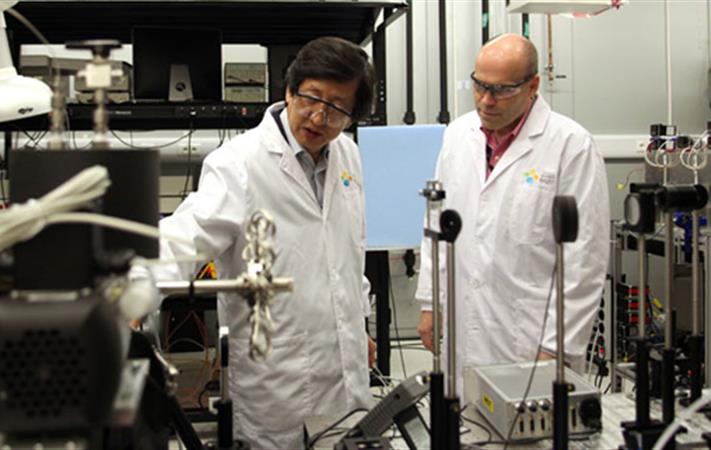KAUST inaugurates Clean Combustion Research Center

Prof. Suk Ho Chung and Prof. William L. Roberts in the CCRC
Five years in the making, the Clean Combustion Research Center (CCRC) at King Abdullah University of Science & Technology (KAUST) was inaugurated this week. Currently comprised of seven faculty members and a team of eighty people, including postdoctoral fellows and PhD students, the center's main mission is to conduct leading combustion research to tackle future energy and environmental challenges.
Since its beginnings in 2009, the center's team has been busy designing the lab spaces, procuring the equipment and building its infrastructure. "The construction was completed just a month ago and we are now celebrating the center's opening," said Prof. Suk Ho Chung, CCRC's Director.
"We've seen dramatic growth just in the last two years" added Prof. William L. Roberts, CCRC's Associate Director. From just two faculty members and one post-doc in the beginning, the goal in the coming years is to eventually have ten faculty members and a group of 120.
A Focus on Science for the Benefit of Industry
Now that the Clean Combustion Research Center is operational, it has attracted industrial funding from companies eager to benefit from the technologies developed at the center. Partners such as Saudi Aramco, as well as potential partners, have participated in the center's opening and workshop.
"At the moment, we are involved in several projects through collaborations with over 15 members around the world," said Prof. Chung. With about 25 international scholars present for the inauguration and workshop, Chung believes this opening will be a good platform to promote future collaborations.
In broad terms, CCRC aims to work on energy and environmental issues related to fossil fuels; especially petroleum and gases. "We are working heavily on engines and gas turbine related research," outlines Prof. Chung. The goal of the center is to improve the processes and make them more efficient. "So we try to identify those mechanisms and provide the scientific data for the relevant industry," he adds.
To that effect, the Clean Combustion Research Center is comprised of three main groups. One group is primarily focused on computational studies; they concentrate on modeling at its finest temporal and spatial scales and make approximations for real devices. Another group is working on developing chemical kinetic models and mechanisms to describe the very complex reactions steps characterized, for instance, by the hundreds of combustion reactions for converting fossil fuels into water and carbon dioxide. A third group specializes in experimental measurements of physical quantities such as temperature, velocity, and individual species for testing these models and mechanisms in both very simple, canonical flames as well as in actual internal combustion engines.
The experiments sometimes involve the study of autoignition and soot formation, or comparative studies of the two types of traditional engines: the compression ignition (diesel) engines and the spark-ignited (gasoline) engines. There are advantages and disadvantages in both diesel and gasoline, but the objective is to marry the advantages of both and eliminate the disadvantages.
As Prof. Roberts explained: "We're not designing engines. We're not designing jet engines or boilers. We're developing the technology to allow those manufacturers to either make them more efficient or less polluting. So we're trying to extend the lifetime of fossil fuels by mitigating the impact on climate change and extending their useful lifetime."
The Impact for the Kingdom and Beyond
"We are producing close to 9 million barrels per day of petroleum so there's a huge demand to be a world leader in fuel formulation, fuel design and fuel technology," Prof. Chung explained. This reality informs CCRS's commitment into conducting goal-oriented research.
The abundance of fossil fuels in Saudi Arabia, and the importance of the region's role in the production of petroleum and gases, makes the value of understanding the scientific mechanisms behind the conversion of this chemical energy into work a priority. "Almost 60% of petroleum is used for transportation fuels. So there's a lot of interest in the kingdom, for example, and around the world on petroleum fuel formulation," added Prof. Chung.
This energy-efficient combustion research, conducted at CCRC, moves towards "the ends of the crude oil spectrum" as Prof. Roberts describes. As efficient ways are devised to exploit heavy fuel oils and vacuum residuals, which are typically very difficult to burn, it becomes possible to burn and consume less desirable and lower cost fuels.
In addition to transportation engines, those fuels are eventually used in power plants. So CCRC is also working with power plants, such as Saudi Electric Company, to improve efficiency.
Laser Technology and Future Bi-Product Applications
Over the past twenty years, laser technology has made large advances and, thus, has influenced the evolution of many scientific fields, including combustion research. In fact, Prof. Chung describes those changes as drastic for his field. "Most of the measurements we do are in-situ measurements," he explained. Laser technology allows scientists to probe and identify detailed structures like never before. For instance, soot formation processes can be detailed highly accurately.
One of the spin-offs of laser-based measurements discovered at KAUST by Prof. Aamir Farooq also has potentially important medical implications. The process involves using a laser beam to detect ammonia from a patient's breath. Experiments were conducted at IMC in Jeddah. "It involves the ability to sense certain molecules at very low concentrations. Currently it's a very complicated process. They do it by testing blood. Here you just breathe over a laser beam and that tells you the answer. Very simple and it's non-intrusive," said Prof. Roberts.

